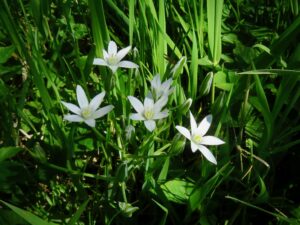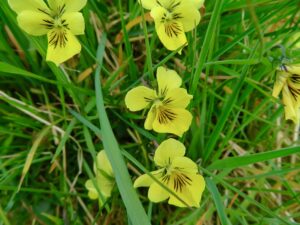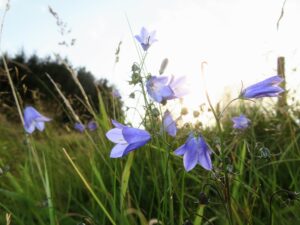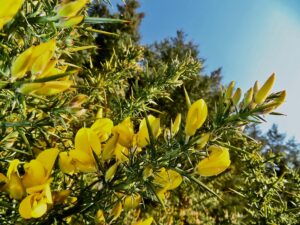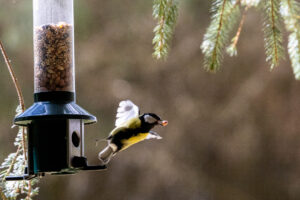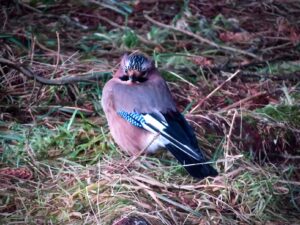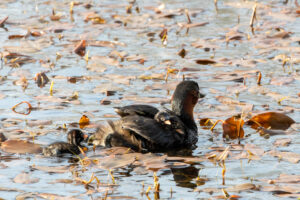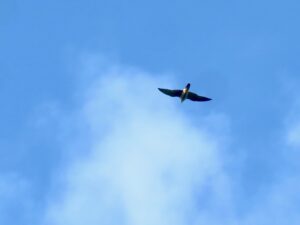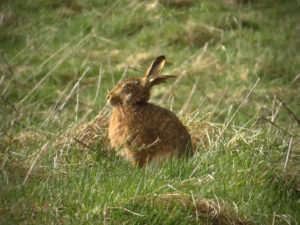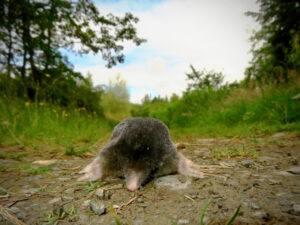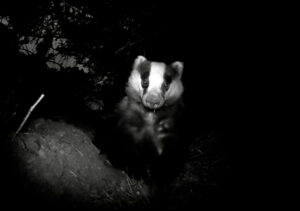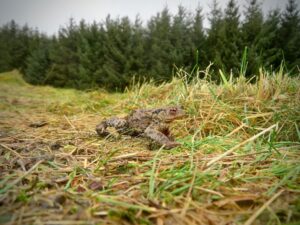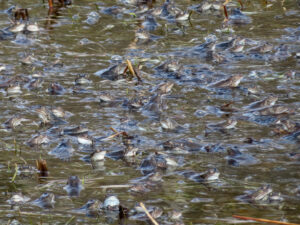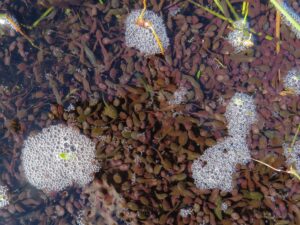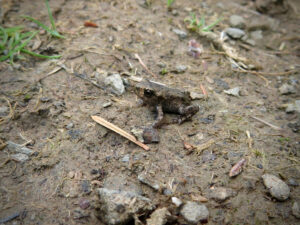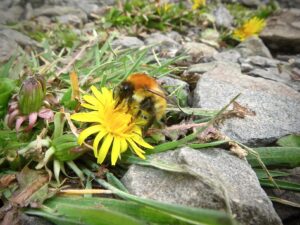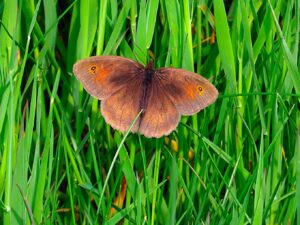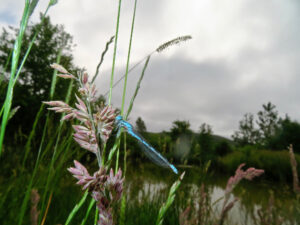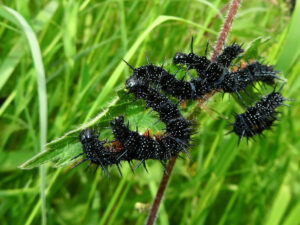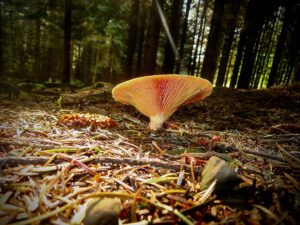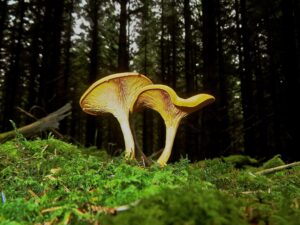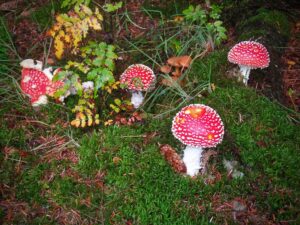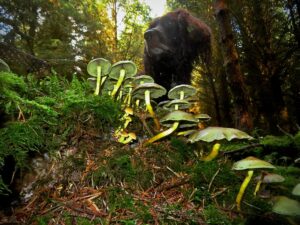
Plants
WILDFLOWERS and trees
There are hundreds of different plants to be found at Broughtonknowe including wildflowers, garden escapes, wet habitat species and of course, trees. Some of the most prominent /abundant species are listed below.
Grassland & Woodland Wildflowers: In approximate order of appearance. Coltsfoot | Lesser Celandine | Dandelion | Dog Violet | Primrose | Wood Anemone | Creping Buttercup | Meadow Buttercup | Mountain Pansy | Germander Speedwell |Tormentil| Cow Parsley | Pig Nut | Hogweed|Forget-me-not| Bitter Vetch| Common Vetchling | Thyme-leaved Speedwell| Heath Bedstraw| Lady's Bedstraw| Thyme| White Clover| Red Clover| Bird's Foot Trefoil| Ribwort Plantain| Bush Vetch| Lesser Stitchwort| Selfheal| Foxglove| Cleavers| Creeping Thistle| Stinging Nettle| Dock| Sorrel| Rose Bay Willowherb| Greater Willowherb| Cat's Ear| Yarrow| Harebell| Sneezewort| Autumn Hawksbit
Wet habitat Wildflowers: Cuckoo Flower | Marsh Marigold| Lesser Spearwort | Marsh Cinquefoil| Ragged Robin| Marsh Thistle | Meadowsweet | Valerian
Garden Escapes: Star of Bethlehem| Welsh Poppy | Arum Lilly| Fox and Cubs | Jacob's Ladder | Lady's Mantle| Figwort
Planted Native Trees: Alder | Aspen | Beech | Birch| Bird Cherry | Black Poplar | Cherry (Gean) | Crab Apple | Field Maple | Hazel | Holly | Larch | Oak | Scots Pine | Sycamore | Whitebeam | Willow species
Wildlife
birds
Broughtonknowe is home to many breeding and migrant birds, including regular and occasional visitors (with the occasional fly-past by a Red Kite, Osprey or Peregrine Falcon).
Breeding Birds: Blackbird | Blue Tit | Bullfinch | Buzzard | Chaffinch | Coal Tit | Goldcrest | Great Tit | Grey Wagtail | Jackdaw | Jay | Little Grebe | Long-tailed Tit | Magpie | Mallard | Mistle Thrush | Moorhen | Pheasant | Pied Wagtail | Robin | Song Thrush | Tawny Owl | Tree Creeper | Wood Pigeon | Wren
Migrant Breeding Birds: Chiffchaff | Blackcap | Swallow | Willow Warbler
Regular and Occasional Visitors: Barn Owl |Carrion Crow | Crossbill | Great Spotted Woodpecker | Grey Heron | House Sparrow | Kestrel | Meadow Pipit | Raven | Reed Bunting | Siskin | Sparrow Hawk | Starling
Migrant Regular and Occasional Visitors: Cuckoo | Fieldfare | Redwing | Stonechat | Wheatear | Woodcock
Wildlife
Insects
Listed below are some of Broughtonknowe's more frequently observed insects (there will be many more species present!).
Butterflies: Peacock | Small Tortoiseshell | Orange -tip | Green Veined White | Small White | Meadow Brown | Red Admiral | Ringlet | Common Blue |Small Heath | Dark Green Fritillary | Small Pearl-bordered Fritillary | Small Skipper | Small CopperDay-flying Moths: Antler Moth | Chimney Sweeper | Cinnabar | Five Spot Burnet | Latticed Heath | Red-shouldered Footman
Night-flying Moths: Beautiful Golden Y | Burnished Brass | Dark Arches | Flame Shoulder | Gold Spangle | Green Carpet | Large Yellow Underwing | Lempke's Gold Spot | Lesser Yellow Underwing | Light Emerald | Silver-ground Carpet | and many more
Dragonflies and Damselflies: Azure Damselfly | Common Blue Damselfly | Common Hawker | Emerald Damselfly | Large Red Damselfly
Bees and Wasps: Common Carder Bumblebee | Garden Bumblebee | Red-tailed Bumblebee |Tree Bumblebee | Tree Wasp | White-tailed Bumblebee
Fungi
Fungi & LICHEN
In approximate order of appearance in the autumn, you can find the following fungi in various locations throughout the woodland habitats:
Larch Bolete | Common Puffball | False Chanterelle | Tawny Funnel | Plums and Custard | Fly Agaric | Spruce Milkcap | Sulphur Tuft | Fragile Brittlegill | Primrose Brittlegill | Cep | Twig Parachute | Common Bonnet | Lilac Bonnet | Orange Bonnet | Wrinkled Club | Yellow Club | Shaggy Scaleycap | Jellybabies | Butter Waxcap |The Blusher | Scaly Wood Mushroom | Cortinarius | Orange Cup (Peel) | Pale Brittlestem | The Miller | Liberty Cap | Wood Mushroom | Field Mushroom | Gooseberry Brittlegill | Crystal Brain Fungus | Tar Spot | Clouded Funnel (Agaric) | Candlesnuff Fungus
Lichens do no damage to the trees just growing on them as ‘epiphytes’. Biologically they are a really interesting combination of Algae (think green patches on tree trunks) and Fungi (moulds, mushrooms, toadstools). The fungal component accommodates the algae and in association they can survive in situations neither could on its own! One thing they do require is clean air. Their absence is a clear indicator of air pollution. This gives the Broughtonknowe air quality a big thumbs up! Common types at Broughtonknowe are species of Evernia, Parmelia and Usnea.With thanks to Sue Bakker – our fungus expert.

